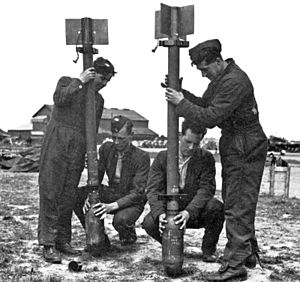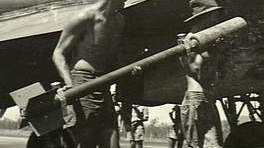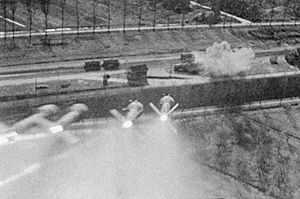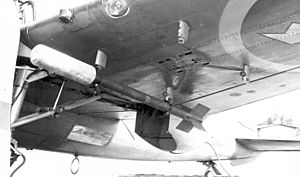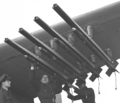RP-3 facts for kids
Quick facts for kids RP-3 |
|
|---|---|
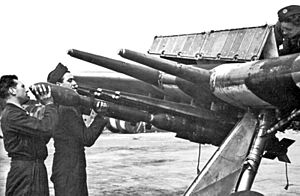
Loading of RP-3 rockets fitted with 60 lb semi-armour-piercing high-explosive warheads onto a Hawker Typhoon
|
|
| Type | Unguided air-to-surface rocket |
| Place of origin | United Kingdom |
| Service history | |
| In service | 1943–1968 (UK) |
| Used by | Royal Air Force, Royal Navy, Royal Australian Air Force and others |
| Wars | World War II, Indonesian National Revolution, Malayan Emergency, Suez Crisis, Korean War, Aden Emergency |
| Production history | |
| Variants | see variants |
| Specifications | |
| Mass | 35 lb (16 kg) 17.9 kg (39 lb) Mk 1 engine 17.2 kg (38 lb) Mk 2, 3, 4 engine |
| Length | 55 in (1.4 m) rocket 20–22 inches (500–560 mm) warhead |
| Diameter | 3.25 in (83 mm) rocket body |
| Warhead | TNT/RDX/Amatol |
| Warhead weight | 1.3–5.5 kg (2.9–12.1 lb) |
|
|
|
| Engine | solid fuel rocket 800 kgf (1,800 lbf) |
| Propellant | cordite |
|
Operational
range |
1,600 m (1,700 yd) |
| Maximum speed | With 25 lb warhead: 380 m/s (1,200 ft/s) With 60 lb warhead: 230 m/s (750 ft/s) |
|
Guidance
system |
unguided |
|
Launch
platform |
Aircraft Landing Craft Tank (Rocket) |
The RP-3 (which stands for Rocket Projectile 3 inch) was a British rocket used by aircraft during World War II. It was designed to be fired from planes at targets on the ground or in the water. The "3 inch" part of its name refers to the size of the rocket's main body. It was also known as the "60-pound rocket" because it often carried a 60-pound (about 27 kg) explosive part.
The RP-3 was mainly used by British fighter-bomber planes. They attacked things like tanks, trains, trucks, and buildings. Planes from Coastal Command and the Royal Navy also used them against U-boats (submarines) and ships. Even after World War II, the RP-3 was used in conflicts until the late 1960s. It was eventually replaced by newer rockets.
Contents
History of the RP-3 Rocket
Rockets were first used from aircraft during World War I. These early rockets, like the Le Prieur rocket, were attached to planes to attack enemy observation balloons. They were quite successful.
After World War I, the Royal Air Force (RAF) didn't focus on aircraft rockets for a while. However, the British Army saw a use for them against low-flying enemy planes. From late 1940, special "Z-Batteries" used 2-inch rockets to help defend Britain alongside regular anti-aircraft guns.
Why the RP-3 was Needed
In 1941, during the Western Desert campaign in North Africa, British forces faced many German tanks. The planes of the Desert Air Force needed stronger weapons to destroy these heavy tanks. Henry Tizard, a top British scientist, gathered experts to find ways to attack armored vehicles.
They looked at different guns, but these were often too heavy for fighter planes or didn't have enough power. So, the idea of using rockets came up. Rockets could carry a much larger explosive part without the heavy recoil of a big gun. The British also learned from the Soviets, who had been using unguided rockets since 1937.
By September 1941, they decided to develop a 3-inch rocket. This larger rocket could be based on the 2-inch rockets already used in the Z-Batteries. This led to the creation of the RP-3.
How the RP-3 was Designed
The RP-3 rocket body was a steel tube about 3.25 inches (8.25 cm) wide and 55 inches (1.4 meters) long. It was filled with about 5.2 kg (11.5 lb) of cordite fuel, which was ignited electrically. The explosive part, called the warhead, was screwed onto the front.
Early warheads included a 24-pound (10.9 kg) armor-piercing one. Soon, a much larger 60-pound (27.2 kg) high-explosive warhead became common. For practice, there were also concrete warheads that weighed the same. Once the rocket was attached to the plane's rails, an electrical wire connected it to the pilot's firing controls.
How the RP-3 Flew
The rocket had four large tailfins that made it spin slightly as it flew. This spin helped keep it stable. However, the RP-3 was "unguided," meaning the pilot had to aim it very carefully. To hit the target, the plane had to fly straight and steady, without wobbling. The pilot also needed to be at the right speed and angle when firing. Hitting targets at long distances was tricky because the rocket would drop as it flew.
One big advantage of the rocket was that it was simpler and more reliable than a gun. It also didn't have the strong kickback (recoil) that a gun would. Pilots found that attacking with rockets was very scary for enemy soldiers on the ground. The 60-pound warhead could cause a lot of damage. These rockets were light enough for single-seat fighter planes, giving them the power of a much larger warship. They were especially good against big, slow targets like ships and submarines.
Improving the Rocket Launchers
At first, British planes used heavy steel rails to launch the rockets. These rails added weight and slowed the planes down. Some planes even needed metal panels to protect their wings from the rocket's exhaust. Later, lighter aluminum rails were introduced.
American rockets showed that long rails weren't always needed. So, by May 1945, "zero-length launchers" were developed. These were much smaller mounts. After the war, British planes also started using these "zero-point" mounts.
The 3-inch rocket motors were even used in a special "bunker buster" bomb called the "Disney bomb". Nineteen of these rocket motors helped push the 4,500-pound (2,040 kg) bomb to very high speeds before it hit its target.
RP-3 in Action
Attacking Targets on Land
Before the RP-3 was used in combat, it was tested extensively. Hawker Hurricane planes were fitted with rockets and tested in 1942 to figure out the best ways to use them. Other planes like the Lockheed Hudson and Fairey Swordfish were also used in tests. Pilots aimed the rockets using a special gun sight.
The first time the RP-3 was used in battle was in North Africa, where Hawker Hurricane planes used them to attack tanks. The early 25-pound armor-piercing warheads weren't very effective against the new, heavy German Tiger I tanks. So, a new 60-pound "semi-armor-piercing" (SAP) warhead was designed. These new warheads were powerful enough to damage or even knock the turrets off tanks.
Typically, a plane would carry four RP-3 rockets under each wing. Pilots could choose to fire them one at a time, in pairs, or all at once. Towards the end of the war, some Hawker Typhoon planes even carried eight rockets under each wing, for a total of sixteen!
The RP-3s were widely used during the Battle of the Falaise pocket in August 1944. German forces were trying to escape, and Allied planes attacked them. Hawker Typhoons fired their rockets, claiming to destroy many tanks and vehicles. After the battle, studies showed that fewer vehicles were actually destroyed by rockets alone. However, it was clear that rocket attacks greatly hurt the morale of enemy troops. Many vehicles were found abandoned, even if they had only minor damage. Captured soldiers said that just the thought of a rocket attack was terrifying.
RP-3 rockets were still used after World War II in conflicts like the Malayan Emergency and the Korean War. The last known combat use was in Aden in 1967. After that, they were replaced by newer rockets.
Attacking Submarines
After seeing how well the rockets worked, trials were done against targets that looked like U-boats (submarines). They found that if rockets were fired at a shallow angle, even if they missed slightly, they would curve upwards underwater and hit the submarine below the water line. Soon, planes from Coastal Command and the Royal Navy's Fleet Air Arm were using rockets a lot.
The first U-boat destroyed with the help of a rocket attack was U-752 on May 23, 1943. A Fairey Swordfish plane used rockets with solid, cast-iron heads. One of these rockets went right through the submarine's strong outer shell, making it unable to dive. The U-boat's crew had to sink it themselves. Just a few days later, an RAF Hudson plane destroyed a U-boat in the Mediterranean, the first one destroyed only by rockets. These rocket attacks made it too dangerous for German U-boats to operate in certain areas.
From then until the end of World War II, rockets became one of the main weapons for Coastal Command and the Fleet Air Arm against ships and surfaced U-boats. They even started to replace torpedoes in some situations.
Using RP-3s on the Ground
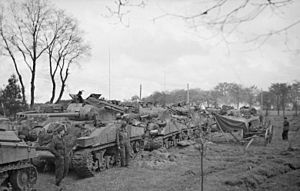
For the Normandy landings in June 1944, special Landing Craft Tank (Rocket) ships were used. Each of these ships carried about 1,000 RP-3 rockets. They could fire huge groups of about 40 rockets at a time to bombard the landing areas.
In 1945, some British Sherman tanks were fitted with two or four rocket rails on their turrets. These tanks were called "Sherman Tulips." They were used during the Rhine Crossing by tanks of the 1st Coldstream Guards.
These tank modifications were first tried by two officers who got rockets and rails from an RAF base. They were inspired by a Canadian unit that had tried fitting rockets to an armored car.
The rockets fired from tanks were not very accurate because the tank was still and the rockets didn't have enough airflow over their fins to stabilize them well. However, tank crews still liked the RP-3 because its 60-pound warhead caused a lot of damage. They used them for short-range attacks to blast an area or to quickly respond to German ambushes.
RP-3 in Sweden
The RP-3 rocket was also used by the Swedish Air Force from 1946 to 1957. Sweden had been working on its own rockets but decided to buy the RP-3 from Britain to gain experience.
In 1946, Sweden ordered RP-3s for testing on their Saab 17 and Saab 18 planes. The tests were successful, and the RP-3 officially entered service with the Swedish Air Force.
In Sweden, the RP-3 system was called "8 cm raket m/46". They used different types of warheads, including armor-piercing, high-explosive, and practice warheads.
By 1952, Sweden had developed its own rockets and began to stop using the RP-3. Some of the remaining RP-3 rockets were updated with new fins to make them more accurate. The last RP-3s were removed from Swedish service in 1957.
Different Types of RP-3 Rockets
The RP-3 rocket came with different types of warheads (the explosive front part) and had updated rocket engines over time.
Warhead Types
- 25-pound Armor-Piercing (AP)
- Shot, 25 lb, AP, No. 1, Mk. I: Made of hardened steel, used against submarines and ships.
- Shot, 25 lb, AP, No. 2, Mk. I: An improved, pointier design for better penetration.
- 25-pound Semi-Armor-Piercing (SAP)
- Shot, 25 lb, SAP, Mk. I: Similar to the AP No. 2 but made of milder steel. Used for advanced training later on.
- 25-pound Practice
- Shot, 25 lb, Practice, Concrete, Mk. I: A concrete warhead used for training, to simulate the AP and SAP warheads.
- 60-pound High-Explosive (HE)
- Shell, HE, 60 lb, "F"., No. 1, Mk. I: A fragmentation warhead for attacking unarmored vehicles and people. It created heavy fragments that could cause damage far away.
- 60-pound Semi-Armor-Piercing High-Explosive (SAP)
- Shell, HE, 60 lb, SAP: This was a very common warhead. It came in different versions (Mk. I and Mk. II, No. 1 and No. 2). Some versions had a time delay so they would explode after hitting the target, while others exploded right away.
- 60-pound Practice
- Shell, Practice, Concrete, 60 lb Mk. I: A concrete warhead for training with the 60-pound SAP/HE warheads. It could also have a smoke container attached to show where it hit.
- 60-pound General Purpose (G.P.)
- Shell, HE, 60 lb, G.P.: A "hollow charge" warhead designed to penetrate thick armor, even up to 198 mm (about 7.8 inches).
Rocket Engine Updates
The RP-3's rocket engine was improved several times. These updates often changed the type of fuel charge or how the ignition worked. Later versions, marked with "TH," could carry the heavier 60-pound warheads.
- Mk. 1 Engine: Used a tube-shaped fuel charge. Good for 25-pound warheads.
- Mk. 1/TH Engine: A Mk. 1 version that could handle 25-pound solid or shell warheads.
- Mk. 2 Engine: Changed to a cross-shaped fuel charge. Only for 25-pound warheads.
- Mk. 2/TH Engine: A Mk. 2 version that could handle warheads up to 60 pounds.
- Mk. 3/TH Engine: Had a different ignition plug.
- Mk. 4/TH Engine: Had longer ignition cables, allowing two RP-3s to be mounted one below the other on a plane.
Aircraft That Used the RP-3
The RP-3 was used on many different types of aircraft during and after World War II.
Aircraft in World War II
- Boeing Fortress Mk. II and IIA (Coastal Command)
- Bristol Beaufighter Mk. VI, VIC, X and 20
- Consolidated Liberator B. Mk. III, VI (Coastal Command)
- de Havilland Mosquito F.B. Mk. VI
- Hawker Hurricane Mk. IIE & IV
- Hawker Typhoon Mk. Ib
- Vickers Wellington GR Mk. XIV (Coastal Command)
- Fairey Firefly Mk. I
- Fairey Swordfish Mk. II, III
- Grumman Tarpon/Avenger Mk. I, II, III
- Hawker Sea Hurricane Mk. IIc
- Hawker Sea Fury
Aircraft After World War II
The RP-3 continued to be used on RAF and Royal Navy planes for ground attacks until newer rockets replaced them.
RAF and Commonwealth Air Forces
- Bristol Brigand
- de Havilland Hornet
- de Havilland Vampire
- de Havilland Venom
- Gloster Meteor
- Hawker Hunter
Australian Air Forces (RAAF, RAN)
- Bristol Beaufighter
- North American P-51 Mustang
- de Havilland Vampire
- Fairey Firefly
- Gloster Meteor
- Fairey Gannet
- Hawker Sea Fury Mk11
- de Havilland Sea Venom
- Hawker Sea Fury
- Hawker Sea Hawk
- Supermarine Attacker
- Supermarine Scimitar
- de Havilland Sea Vixen
Swedish Air Force
- North American T-6 Texan (Sk 16)
- Saab 17 (B 17A)
- Saab 18 (A & T 18B)
- Saab 21 (A 21A-3)
- Saab 21R (A 21RA, RB)
- de Havilland Vampire (J 28B, C)
- Saab 29 Tunnan (J 29A, B, E, F)
- Saab 32 Lansen (A 32A)
Images for kids
-
Shot, 25 lb, AP, No. 1, Mk. I rockets loaded onto a Bristol Beaufighter of Coastal Command.
-
Shot, 25 lb, AP, No. 2, Mk. I rockets loaded onto a de Havilland Mosquito.
See also
- M8 - An American air-to-ground rocket.
- Land Mattress - A Canadian multiple rocket launcher.
- Tiny Tim - A very large American unguided rocket.


